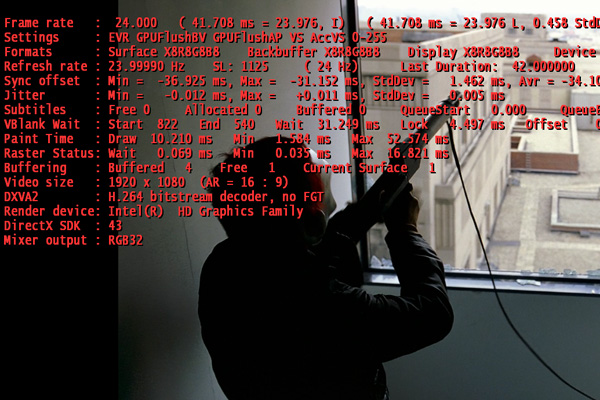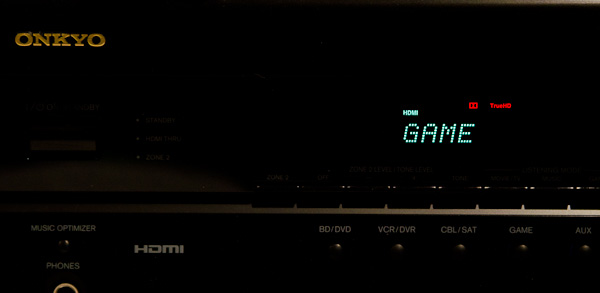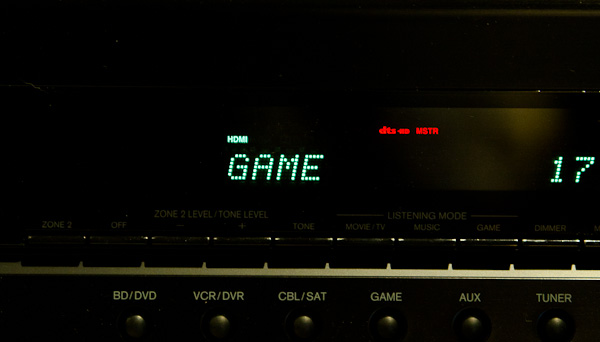The Sandy Bridge Review: Intel Core i7-2600K, i5-2500K and Core i3-2100 Tested
by Anand Lal Shimpi on January 3, 2011 12:01 AM ESTA Near-Perfect HTPC
Since 2006 Intel’s graphics cores have supported sending 8-channel LPCM audio over HDMI. In 2010 Intel enabled bitstreaming of up to eight channels of lossless audio typically found on Blu-ray discs via Dolby TrueHD and DTS-HD MA codecs. Intel’s HD Graphics 3000/2000 don’t add anything new in the way of audio or video codec support.
Dolby Digital, TrueHD (up to 7.1), DTS, DTS-HD MA (up to 7.1) can all be bitstreamed over HDMI. Decoded audio can also be sent over HDMI. From a video standpoint, H.264, VC-1 and MPEG-2 are all hardware accelerated. The new GPU enables HDMI 1.4 and Blu-ray 3D support. Let’s run down the list:
Dolby TrueHD Bitstreaming? Works:
DTS HD-MA bitstreaming? Yep:
Blu-ray 3D? Make that three:
How about 23.976 fps playback? Sorry guys, even raking in $11 billion a quarter doesn’t make you perfect.
Here’s the sitch, most movie content is stored at 23.976 fps but incorrectly referred to as 24p or 24 fps. That sub-30 fps frame rate is what makes movies look like, well, movies and not soap operas (this is also why interpolated 120Hz modes on TVs make movies look cheesey since they smooth out the 24 fps film effect). A smaller portion of content is actually mastered at 24.000 fps and is also referred to as 24p.
In order to smoothly playback either of these formats you need a player and a display device capable of supporting the frame rate. Many high-end TVs and projectors support this just fine, however on the playback side Intel only supports the less popular of the two: 24.000Hz.
This isn’t intentional, but rather a propagation of an oversight that started back with Clarkdale. Despite having great power consumption and feature characteristics, Clarkdale had one glaring issue that home theater enthusiasts discovered: despite having a 23Hz setting in the driver, Intel’s GPU would never output anything other than 24Hz to a display.
The limitation is entirely in hardware, particularly in what’s supported by the 5-series PCH (remember that display output is routed from the processor’s GPU to the video outputs via the PCH). One side effect of trying to maintain Intel’s aggressive tick-tock release cadence is there’s a lot of design reuse. While Sandy Bridge was a significant architectural redesign, the risk was mitigated by reusing much of the 5-series PCH design. As a result, the hardware limitation that prevented a 23.976Hz refresh rate made its way into the 6-series PCH before Intel discovered the root cause.
Intel had enough time to go in and fix the problem in the 6-series chipsets, however doing so would put the chipset schedule at risk given that fixing the problem requires a non-trivial amount of work to correct. Not wanting to introduce more risk into an already risky project (brand new out of order architecture, first on-die GPU, new GPU architecture, first integrated PLL), Intel chose to not address it this round, which is why we still have the problem today.

Note the frame rate
What happens when you try to play 23.976 fps content on a display that refreshes itself 24.000 times per second? You get a repeated frame approximately every 40 seconds to synchronize the source frame rate with the display frame rate. That repeated frame appears to your eyes as judder in motion, particularly evident in scenes involving a panning camera.
How big of an issue this is depends on the user. Some can just ignore the judder, others will attempt to smooth it out by setting their display to 60Hz, while others will be driven absolutely insane by it.
If you fall into the latter category, your only option for resolution is to buy a discrete graphics card. Currently AMD’s Radeon HD 5000 and 6000 series GPUs correctly output a 23.976Hz refresh rate if requested. These GPUs also support bitstreaming Dolby TrueHD and DTS-HD MA, while the 6000 series supports HDMI 1.4a and stereoscopic 3D. The same is true for NVIDIA’s GeForce GT 430, which happens to be a pretty decent discrete HTPC card.
Intel has committed to addressing the problem in the next major platform revision, which unfortunately seems to be Ivy Bridge in 2012. There is a short-term solution for HTPC users absolutely set on Sandy Bridge. Intel has a software workaround that enables 23.97Hz output. There’s still a frame rate mismatch at 23.97Hz, but it would be significantly reduced compared to the current 24.000Hz-only situation.
MPC-HC Compatibility Problems
Just a heads up. Media Player Classic Home Cinema doesn't currently play well with Sandy Bridge. Enabling DXVA acceleration in MPC-HC will cause stuttering and image quality issues during playback. It's an issue with MPC-HC and not properly detecting SNB as far as I know. Intel has reached out to the developer for a fix.














283 Comments
View All Comments
mosu - Monday, January 3, 2011 - link
If I want to spend every year a big lot of money on something I'll sell on eBay at half price a few months later and if I'd like crappy quality images on my monitor, then I would buy Sandy Bridge... but sorry, I'm no no brainer for Intel.nitrousoxide - Monday, January 3, 2011 - link
It really impressed me as I do a lot of video transcoding and it's extremely slow on my triple-core Phenom II X3 720, even though I overclocked it to 4GHz. But there is one question: the acceleration needs EU in the GPU, and GPU is disabled in P67 chipset. Does it mean that if I paired my SNB with a P67 motherboard, I won't be able to use the transcoding accelerator?nitrousoxide - Monday, January 3, 2011 - link
Not talking about SNB-E this time, I know it will be the performance king again. But I wonder if Bulldozer can at least gain some performance advantage to SNB because it makes no sense that 8 cores running at stunning 4.0GHz won't overrun 4 cores below 3.5GHz, no matter what architectural differences there are between these two chips. SNB is only the new-generation mid-range parts, it will be out-performed by High-End Bulldozers. AMD will hold the low-end, just as it does now; as long as the Bulldozer regain some part that Phenoms lost in mainstream and performance market, things will be much better for it. Enthusiast market is not AMD's cup of tea, just as what it does in GPUs: let nVidia get the performance king and strike from lower performance niches.strikeback03 - Tuesday, January 4, 2011 - link
I don't think we'll know until AMD releases Bulldozer and Intel counters (if they do). Seems the SNB chips can run significantly faster than they do right now, so if necessary Intel could release new models (or a firmware update) that allows turbo modes up past 4GHz.smashr - Monday, January 3, 2011 - link
This review and others around the web refer to the CPUs as 'launching today', but I do not see them on NewEgg or other e-tailer sites.When can we expect these babies at retail?
JumpingJack - Monday, January 3, 2011 - link
They are already selling in Malaysia, but if you don't live in Malasia then your are SOL :) ... I see rumors around that the NDA was suppose to expire on the 5th with retail availability on the 9th... I was thinking about making the leap, but think I will hold off for more info on BD and Sk2011 SB.slickr - Monday, January 3, 2011 - link
Intel has essentially shoot itself in the foot this time. Between the letters restrictions, the new chipset and crazy chipset differentiations between a P and a H its crazy.Not to mention they lack USB 3.0, ability to have an overclock mobo with integrated graphics and the stupid turbo boost restrictions.
I'll go even more and say that the I3 core is pure crap and while its better than the old core I3 they are essentially leaving the biggest market the one up the $200 dollars wide open to AMD.
Those who purchase CPU's at $200 and higher have luck in the 2500 and 2600 variants, but for the majority of us who purchase cpu's bellow $200 its crap.
Essentially if you want gaming performance you buy I3 2100, but if you want overall better performance go for a phenom II.
Hopefully AMD comes up with some great CPU's bellow the $200 range that are going to be with 4 cores, unlimited turbo boost and not locked.
Arakageeta - Tuesday, January 4, 2011 - link
It seems that these benchmarks test the CPUs (cores) and GPU parts of SandyBridge separately. I'd like to know more about the effects of the CPU and GPU (usually data intensive) sharing the L3 cache.One advantage a system with a discrete GPU is that the GPU and CPUs can happily work simultaneously without largely affecting one another. This is no longer the case with SandyBridge.
A test I would like to see is a graphics intensive application running while another another application performs some multi-threaded ATLAS-tuned LAPACK computations. Do either the GPU or CPUs swamp the L3 cache? Are there any instances of starvation? What happens to the performance of each application? What happens to frame rates? What happens to execution times?
morpheusmc - Tuesday, January 4, 2011 - link
To me it seems that marketing is defining the processors now in Intel rather than engineering. This is always the case but I think now it is more evident than ever.Essentially if you want he features that the new architecture brings, you have to sell out for the higher end models.
My ideal processor would be a i5-2520M for the desktop: Reasonable clocks, good turbo speeds (could be higher for the desktop since the TDP is not that limited), HT, good graphics etc. The combination of 2 cores and HT provides a good balance between power consumption and perfromance for most users.
Its desktop equivalent price-wise is the 2500, wich has no HT and a much higher TDP because of the four cores. Alternatively, maybe the 2500S, 2400S or 2390T could be considered if they are too overpriced.
Intel has introduced too much differentiation in this generation, and in an Apple-like fashion, i.e. they force you to pay more for stuff you don't need, just for an extra feature (eg. VT support, good graphics etc) that practically costs nothing since the silicon is already there. Bottomline, if you want to have the full functionality of the silicon that you get, you have to pay for the higher end models.
Moreover, having features for specific functions (AES, transcoding etc) and good graphics makes more sense in lower-end models where CPU power is limited.
This is becoming like the software market, where you have to pay extra for licenses for specific functionalities.
I wouldn't be surprised if Intel starts selling "upgrade licenses" sometime in the future that will simply unlock features.
I strongly prefer AMD's approach where all the fatures are available to all models.
I am also a bit annoyed that there is very little discusison about this problem in the review. I agree that technologically Sandy Bridge is impressive, but the artificial limiting of functionality is anti-technological.
ac2 - Tuesday, January 4, 2011 - link
Agreed, but, apart from the K-series/ higher IGP/ motherboard mess up (which I think should be shortly cleared up), all the rest of it is just smart product marketing...It irritates readers of AnandTech, but for the most people who buy off-the-shelf it's all good, with integrators patching up any shortcomings in the core/ chipset.
The focus does seem to be mobile, low-power and video transcode, almost a recipe for macbook!!